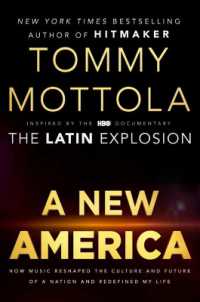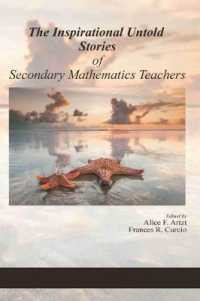- ホーム
- > 洋書
- > 英文書
- > Science / Mathematics
Full Description
This Scientific and Technical Report (STR) provides in-depth fundamentals and guidelines regarding Computational Fluid Dynamics (CFD) simulations of Water Resources Recovery Facilities (WRRFs) unit processes (e.g. headworks, aerobic and anaerobic biological reactors, settling tanks, disinfection).
Each unit process is described with respect to:
Literature review and process description
Relevant CFD concepts and modelling approach
Case studies
Future research needs
CFD Modelling for Wastewater Treatment Processes also opens the discussion on two fundamental topics: experimental validation of CFD simulations, and the complementarity between CFD and Chemical Reaction Engineering approaches. This book is intended for undergraduate and graduate students majoring in fields related to wastewater treatment and/or fluid mechanics, as well as researchers and engineers who conduct research and practices in modelling such unit processes. Water resource recovery modelling is not just about lab-scale processes. Now and in the future, it is about improving our understanding of (and designing better) full-scale facilities!
Contents
About the Chapter Authors
Preface
Foreword
Acknowledgements
Chapter 1
Why CFD?
Randal Samstag and Jim Wicks
Chapter 2
Fundamentals
Randal Samstag, Edward Wicklein, Rainier Hreiz, Julien Laurent, Jim Wicks and Damien Batstone
Chapter 3
Hydraulic analysis and headworks
Edward Wicklein
Chapter 4
Suspended growth tanks
Anna M. Karpinska Portela, Usman Rehman and Jim Wicks
Chapter 5
High-rate algal ponds
Julien Laurent and Tewodros Meless Teshome
Chapter 6
Sedimentation
Alonso G. Griborio, Maria Elena Valle-Medina, Ed Wicklein and Julien Laurent
Chapter 7
Disinfection
Christopher DeGroot, Edward Wicklein and Stephen Saunders
Chapter 8
Anaerobic digestion
David Fernandes Del Pozo, Damien Batstone and Jim Wicks
Chapter 9
Validation
Min Yang, David Fernandes del Pozo and Ingmar Nopens
Chapter 10
How other simulation methods and digital/experimental tracer experiments can be useful for CFD with reactions
Olivier Potier, Julien Laurent, Rainier Hreiz and Damien Batstone
Index








